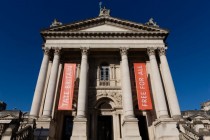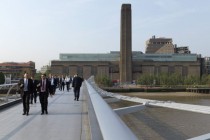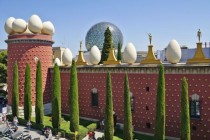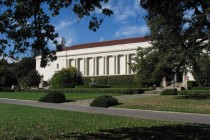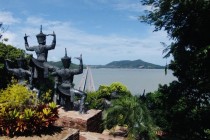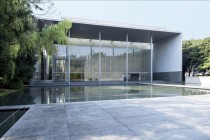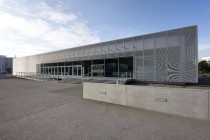| Taj Mahal |
98. |
369 |
India |
Agra |
|
|
Mausoleum
|
More |
Taj Mahal (Taj Museum inside Taj Mahal Complex founded in 1906).
Taj Mahal is a mausoleum built in 1632–53 by the Mughal emperor Shah Jahan to house the tomb of his prematurely deceased beloved wife, Mumtaz Mahal. It covers an area of 17 hectares.
|
| Tate Britain |
146. |
230 |
United Kingdom |
London |
|
|
Art
|
More |
Tate Britain has been under this name since 2000. The origins of Tate Britain date back to 1897. Tate Britain presents British painting and sculpture from 1500 to the present day. The collection includes paintings by William Blake, JMW Turner, and Francis Bacon.
Tate Britain, Millbank façade. Photocredit: Rikard Osterlund
|
| Tate Modern |
9. |
856 |
United Kingdom |
London |
|
|
Art
|
More |
The opening of Tate Modern took place in 2000. Tate Modern collects art collections of the 20th and 21st centuries. Exhibition area 55,000 square meters.
Tate Modern exterior from the Millennium Bridge. Photocredit: Tate Photography
|
| Teatre-Museu Dalí |
85. |
746 |
Spain |
Figueres |
|
|
Art
|
More |
Teatre-Museu Dalí, opened in 1974, is dedicated to its creator Salvador Dalí. In the hometown of the painter Figueres you can see the Teatre-Museu and Jewels. Nearby: Port Lligat - Salvador Dali House and in Pubol - Gala Dali Castle. The museums are run by Fundacio Dali.
|
| Tel Aviv Museum of Art |
149. |
421 |
Israel |
Tel Aviv |
|
|
Art
|
More |
Tel Aviv Museum of Art was established in 1932.
It collects contemporary and modern art. Its collections include works by, among others: Gustav Klimt, Wassily Kandinsky, Pablo Picasso, Roy Lichtenstein, Henry Moore, Jackson Pollock.
|
| The "Wieliczka" Salt Mine |
362. |
140 |
Poland |
Wieliczka |
|
|
Mining
|
More |
The "Wieliczka" Salt Mine is one of the oldest rock salt mines in the world. The "Wieliczka" Salt Mine has more than 7 centuries of exploitation of the salt deposit, 2,391 chambers and 245 km of galleries, 9 main levels at a depth of 57 to 327 meters.
In the "Wieliczka" Salt Mine, on the 3rd level, at a depth of 135 meters, there is the Cracow Saltworks Museum in Wieliczka. The Cracow Saltworks Museum founded in 1951, apart from the underground part, also has a second part on the surface in the medieval Saltworks Castle. The museum presents the history of the mine, tools and devices used to extract and transport salt, and the history of the city of Wieliczka.
The museum's collection consists of about 20,000 exhibits.
|
| The Broad |
254. |
558 |
USA |
Los Angeles |
|
|
Contemporary art
|
More |
The Broad opened to the public in 2015.
The Broad collection includes contemporary art from the 1950s to the present day. The entire collection includes over 2,000 works, including by: Jeff Koons, Roy Lichtenstein, Andy Warhol, Yayoi Kusama, Ragnar Kjartansson, Jean-Michel Basquiat, Joseph Beuys, Jasper Johns, and Robert Rauschenberg. The Broad has the largest Cindy Sherman collection in the world.
The Broad building has an area of 11,150 square meters, of which 4,645 square meters is an exhibition space.
|
| The Huntington |
242. |
161 |
USA |
San Marino |
|
|
Library, art museum,... botanical gardens
|
More |
The Huntington - Library, Art Museum, and Botanical Gardens founded in 1919, open to the public in 1928.
The library has approximately 11 million items from the 11th to 21st centuries.
The museum focuses on 18th and 19th century British painting and design (e.g. Thomas Gainsborough, Thomas Lawrence, William Morris) and American art from the 17th to 20th centuries (e.g. Mary Cassatt, Edward Hopper, Andy Warhol, Robert Rauschenberg).
The gardens cover 49 ha and show plants from all over the world.
Photo: The Huntington Library Exhibition Hall exterior
|
| The Institute for Southern Thai Studies, Thaksin University |
372. |
297 |
Thailand |
Songkhla |
|
|
Folklore Museum
|
More |
The Institute for Southern Thai Studies, Thaksin University is located in Moo 1, Baan Ao Sai, KohYor Sub-District, near the second part of Tinsulanonda Bridge. It was established in 1978 to be an art and culture learning centerfor thef southern region. Its total area is 23 rai. The buildings are in a southern architectural style. The institute is divided into 4 buildings, and each building is divided into various rooms to exhibit history, ethnicity, ancient objects from local wisdom, weapons used in the southern region such as daggers, dagger-sharped knives, RawiAyams, local weaving clothes such as "Pha or PumRiang" and "Pha Tor Pattani", various patterns of rare coconut graters, local plays such as "Nang Talung", "Norah", and "Likaypha", local games and toys such as "SudRao", kite, and top, ordain ceremony, and traditional aid. The institute provides accommodations for visitors, seminar rooms, and traditional product shops, including Krajood handicraft, Panan handicraft, Yan Lipao handicraft, KohYor weaving clothes, products from shells and coconut shells, and silverware. The institute received the best cultural tourist attraction from the Thailand Tourism Authority in 2000. From the viewpoint of the institute, you can see the beautiful scenery of Songkhla Lake. The institute was established when Academic Education College opened the new southern campus in Songkhla Province in 1968. The collegians at that time studied Thai as one of their minor subjects and collected data for studying folkloristics. As a result, they got a lot of cultural information, including real objects, Thai Uricaceae books, and oral literature. This valuable data was collected systematically with the target and became the "Local Southern Literature Room" and "Southern Region Language and Cultural Center" on November 14, 1975. In the same year, the center received the annual government statement of expenditure to build the buildings for Thai Studies and the Southern Region Language and Cultural Center for 4,589,200 baht. The buildings were built in the area of Srinakharinwirot University, Songkhla Campus. The construction was completed in 1978. King Bhumibol, Queen Sirikit, and Princess Sirindhorn came to open the buildings on September 13, 1979. Later, the Ministry of University Affairs agreed to promote the center as "the Institute for Southern Thai Studies."
|
| The Tank Museum |
388. |
173 |
United Kingdom |
Bovington |
|
|
Military
|
More |
The Tank Museum was established in 1947.
The Tank Museum has a very large and varied collection centred mainly on armoured fighting vehicles, but also including related artefacts, archives and supporting objects. Here are the main components of what it holds:
Main Collections
1. Tank / Armoured Fighting Vehicle Collection
- Almost 300 vehicles from over 26 countries.
- Vehicles span from the early prototypes of WWI (e.g. Little Willie) through to modern main battle tanks (e.g. Challenger 2).
- Highlights include:
• Tiger 131, the only operational Tiger I in the world.
• Rare WWI machines (Marks I, IV, V etc.).
• Cold War tanks (T-54, T-62, etc.) and vehicles from post-WWII conflicts and development.
2. Archive & Supporting Collection
- The museum maintains a research archive designated as a Place of Deposit for The National Archives.
- Formats include: documents, technical drawings, maps, photographs, moving images, books, journals, etc., largely centred on armoured warfare and the history of the Royal Armoured Corps / Royal Tank Regiment.
- The Supporting Collection (non-vehicle objects) includes uniforms, medals, flags, weapons and ammunition, models, art, radios, technical instruments etc.
3. Exhibition Halls / Themed Displays
- The Museum is organised into halls by era or theme: WWI Hall, Inter-War Hall (“War Horse to Horsepower”), WWII Hall, “The Tank Story Hall”, plus Cold War / modern era halls.
- There is also a Vehicle Conservation Centre where some of the collection (or parts of it) are displayed in states of restoration / maintenance, giving visitors insight into how conservation work is done.
4. Memorial & Commemorative Components
|
| Three Gorges Museum |
47. |
796 |
China |
Chongqing |
|
|
History
|
More |
Three Gorges Museum opened in 2005.
The museum covers an area of about 42,500 square meters. The exhibition hall itself has an area of about 23,200 square meters.
The main exhibitions are dedicated to:
- Glorious Three Gorges
- Ancient Ba-Yu - early history of Chongqing
- Chongqing: the City Road – 20th century history
In addition, the museum presents exhibitions: porcelain, calligraphy, painting, sculpture from the Han dynasty, coins.
|
| Tianjin Natural History Museum |
205. |
438 |
China |
Tianjin |
|
|
Natural history
|
More |
The origins of the Tianjin Natural History Museum date back to 1914. It has been operating in its present organizational form since 1952.
In the museum, we will see various dinosaurs such as: Tyrannosaurus Rex or Triceratops.
The museum houses over 400,000 geological, palaeontological and biological specimens.
The museum covers an area of 50,000 square meters, of which 35,000 square meters are in the buildings. Exhibition area of 14,000 square meters.
|
| Tikal |
207. |
250 |
Guatemala |
Flores |
|
|
Archaeological park
|
More |
Tikal is a ruin of a Mayan city that functioned from the 4th century BC to the 10th century AD. The greatest development of the city of Tikal is in the years from about 200 to about 900.
The architecture of Tikal includes 6 main temples in the form of pyramids, the highest of which is 65 meters high, monumental royal palaces, smaller mansions, a number of administrative buildings, platforms, altars, lintels, stelae, burials.
Highlights of Tikal: Great Plaza, Central Acropolis, North Acropolis, South Acropolis, Plaza of the Seven Temples, Mundo Perdido, nine Twin-Pyramid Complexes.
The former city is located in Tikal National Park, which covers 575 square kilometers of jungle and thousands of ruined buildings.
Tikal National Park is home to the Stelae Museum and the Sylvannus G. Morley Museum.
|
| Tiwanaku |
387. |
206 |
Bolivia |
Tiwanaku |
|
|
Archaeological site
|
More |
The ruins of Tiwanaku (Tiahuanaco), a pre-Columbian city, cover an area of approximately 400 hectares.
Tiwanaku is located at an altitude of approximately 3,850 meters above sea level.
The city was founded around 110 AD and collapsed around 1000 AD. The city was first recorded in written history in 1549 by the Spanish conquistador.
The main structures are the Akapana, Kalasasaya, Pumapunku and the Semi-Subterranean Temple terraced step platforms. Other monuments include the Gate of the Sun, Gate of the Moon, Fraile Monolith, Bennett Monolith.
Tiwanaku is home to the Museo Cerámico and Museo Lítico administered by the Centro de Investigaciones Arqueológicas, Antropológicas y Administración de Tiwanaku (CIAAAT) and the Museo Regional de Arqueología de Tiwanaku administered by the Dirección Nacional de Arqueología y Antropología (DINAAR).
|
| Tokyo Imperial Palace |
134. |
201 |
Japan |
Tokyo |
|
|
Historic house
|
More |
The main residence of the Emperor of Japan. A complex of buildings and pavilions for various purposes and gardens covering an area of 115 hectares. The current Imperial Palace is located within the former Edo Castle (Tokyo was formerly Edo). In 1888, the construction of the imperial castle was completed, which was destroyed during World War II and rebuilt after it. The renovation and modernization of the entire complex was completed in 1968. Main facilities include: Imperial Palace (Kyūden), Imperial Household Agency, Museum of the Imperial Collections, Archives and Mausolea Department.
Museum of the Imperial Collections was opened in 1993. It has collected around 9,500 works of art in its collection. It is mainly Japanese painting (Nihonga), calligraphy, sculpture, arts and crafts.
|
| Tokyo Metropolitan Art Museum |
32. |
1376 |
Japan |
Tokyo |
|
|
Art
|
More |
Tokyo Metropolitan Art Museum was first opened in 1926 as the Tokyo Prefectural Museum of Art. The museum mainly exhibits the work of leading Japanese and foreign artists at temporary exhibitions. Exhibitions cover a very wide spectrum from traditional Japanese exhibitions from the Edo period, calligraphy and wood engraving to Art Nouveau, paintings by Van Gogh, Gauguin, Klimt, Munch and new wave art.
|
| Tokyo National Museum |
37. |
649 |
Japan |
Tokyo |
|
|
Art
|
More |
Tokyo National Museum was founded in 1872.
The most important part of the collection is ancient and medieval Japanese art, monuments of the Silk Road and Greek-Buddhist art.
The collection consists of over 110,000 objects.
Photo: Facade of the Gallery of Hōryūji Treasures, Tokyo National Museum
|
| Topkapı Palace Museum |
179. |
165 |
Turkiye |
Istanbul |
|
|
Historic house
|
More |
Topkapı Palace Museum opened in 1924.
Topkapı Palace was the residence of the Ottoman sultans. The construction of the palace began in 1459. Main parts of the palace: Imperial Gate, Four Courtyards, Harem, Imperial Treasury. Topkapı Palace covers an area of approximately 650,000 square meters.
The museum's collections include: Topkapı Dagger, Spoonmaker Diamond, religious relics, a collection of Ottoman and European weapons and armor, a collection of Chinese porcelain.
|
| Topography of Terror |
109. |
341 |
Germany |
Berlin |
|
|
Memorial
|
More |
The Topography of Terror opened to the public in 2010.
During the Third Reich (1933-1945), the site currently occupied by The Topography of Terror was the seat of the Gestapo, SS and the Reich Main Security Office. Nazi buildings were destroyed by the Allied bombing in 1945. Later the Berlin Wall passed through this place. A large part of the Wall in The Topography of Terror survived to this day. The first exhibitions in this place took place from 1987.
Entrance to the documentation center
|
| Tower of London |
164. |
241 |
United Kingdom |
London |
|
|
Historic house
|
More |
Tower of London defensive and palace structure of the monarchs of England, used in the past also as a prison. The main building of the White Tower was erected in 1078 for William the Conqueror. Today the Tower of London is managed by Historic Royal Palaces. The Tower of London stores numerous armor, weapons, jewels and coronation insignia, e.g. the scepter with the world's largest Cullinan I diamond and the the Crown Jewels decorated with the world's second-largest Cullinan II diamond. The Tower of London is currently a tourist attraction of London open to visitors. The Tower of London is home to the Fusiliers Museum. The Tower of London covers an area of 4.9 hectares.
|
| Tretyakov Gallery |
48. |
1369 |
Russia |
Moscow |
|
|
Art
|
More |
The Tretyakov Gallery founded in 1856.
The Tretyakov Gallery collects Russian art from the 11th century to the present day.
The collection has over 200,000 exhibits.
Branches:
- Tretyakov Gallery
- House-Museum of Pavel Korin
- Museum-workshop of Anna Golubkina
- Apollinarius Vasnetsov Museum-Apartment
- House-Museum of Viktor Vasnetsov
- New Tretyakov Gallery
- in Kaliningrad, Vladivostok, Samara
|
| Tsarskoe Selo |
114. |
156 |
Russia |
Pushkin |
|
|
Historic house
|
More |
Tsarskoe Selo (the Tsarskoe Selo State Museum and Heritage Site) was the summer residence of the Russian Tsars. Expanded from the beginning of the 18th century to the beginning of the 20th century. The main buildings of the residential complex are Catherine Palace erected in the style of Russian Baroque and the classical Alexander Palace. There was now a lost Amber Room in Catherine Palace. Currently, the reconstruction can be visited at Catherine Palace. In the palace-and-park ensemble of Tsarskoe Selo covering an area of 300 hectares, there are scattered over one hundred historical monuments.
In 1918, Catherine Palace was opened as a museum.
|





